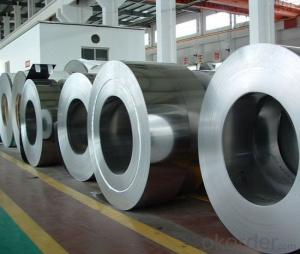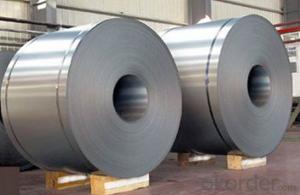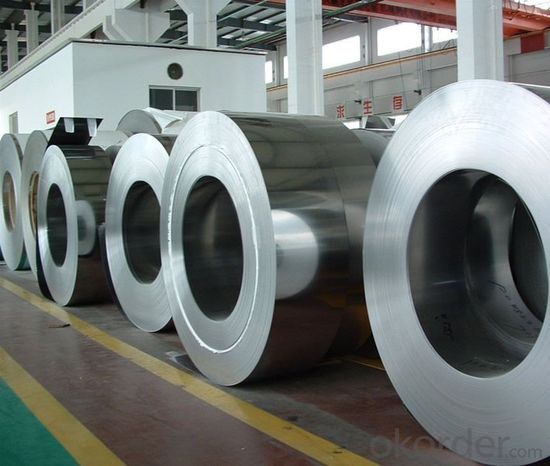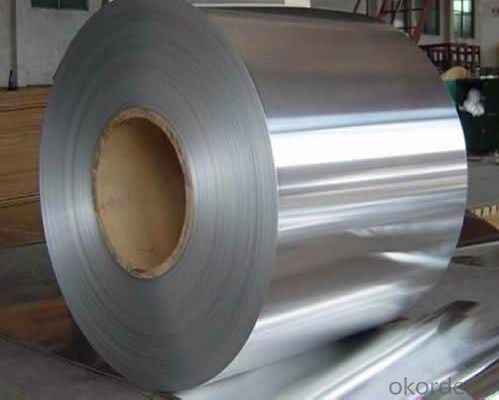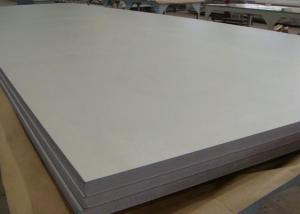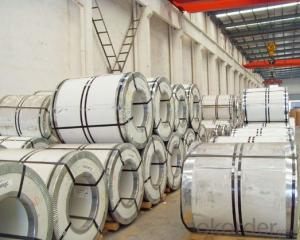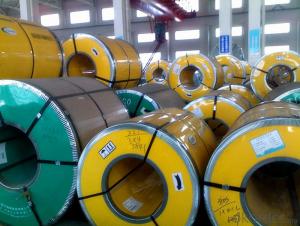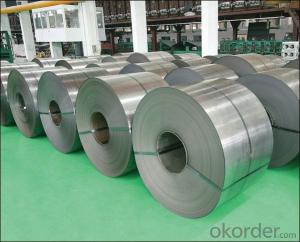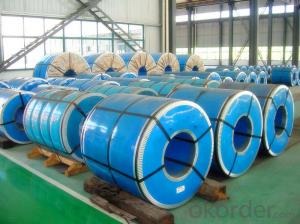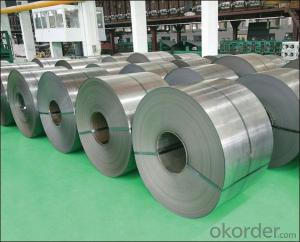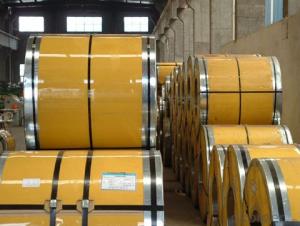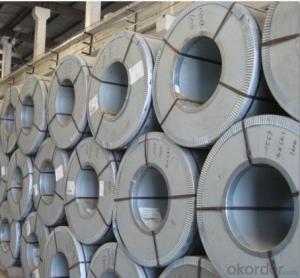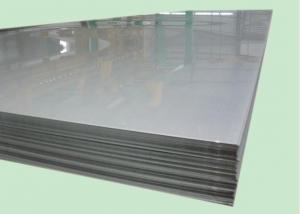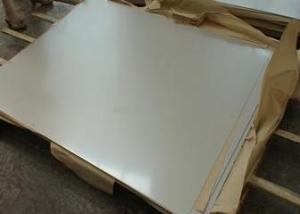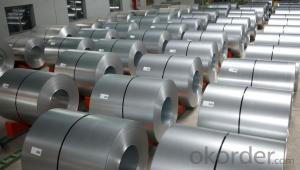Stainless Steel Coil 201 Hot Rolled Narrow Coil J4
- Loading Port:
- Lianyungang
- Payment Terms:
- TT OR LC
- Min Order Qty:
- 500 m.t.
- Supply Capability:
- 8000 m.t./month
OKorder Service Pledge
OKorder Financial Service
You Might Also Like
Hot Rolled Stainless Steel Coil
201 Narrow/Wide Strip No.1 Finish
Packaging Detail: For customer's requirement
Delivery Detail: 10-30days
201 Hot Rolled Stainless Steel Coil Specifications
THK:2.3/2.5/3.0/4.0mm
Width:485/510/550/610/1010/1240mm
Face:No.1
201 Hot rolled stainless steel Coil Application
Stainless steel is a production which not easy rust,acid resistance and corrosion resistance,so it is widely
used in light industry,heavy industry,daily necessities and the decoration industry.
201 Hot Stainless Steel Coil Chemical Composition(WT%)
(C):≤0.15, (Si):≤0.75, (Mn):5.5~7.50, (Cr):16.0~18.0, (N):≤0.25, (Ni):3.50~5.50, (P):≤0.060, (S):≤0.030
201 Hot Rolled Stainless Steel Coil
Strength Of Extension:100,000 To 180,000 Psi;
Yield Strength:50,000 To 150,000 Psi
Elongation :55 To 60%;
Modulus Of Elasticity:29,000,000 Psi;
Density :.280lbs/Cubic Inch(7.93g/Cm3)
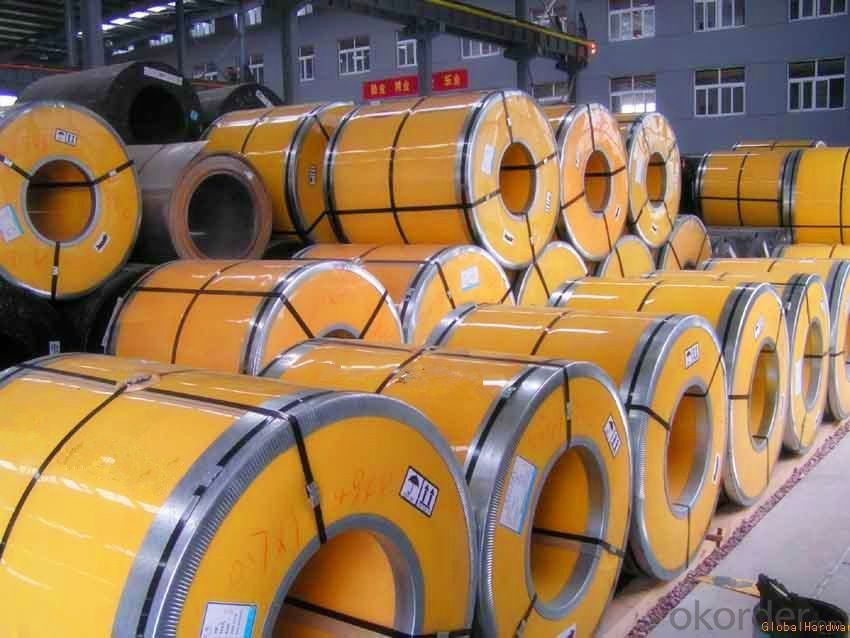
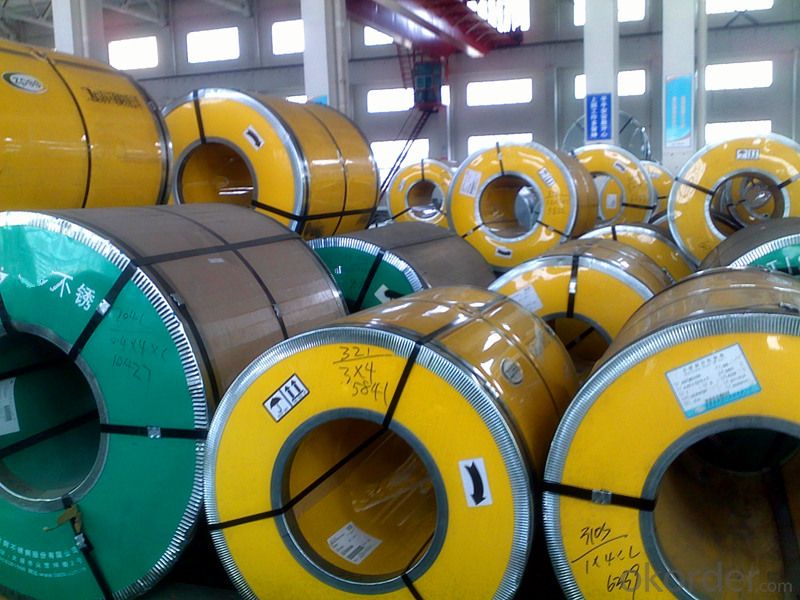
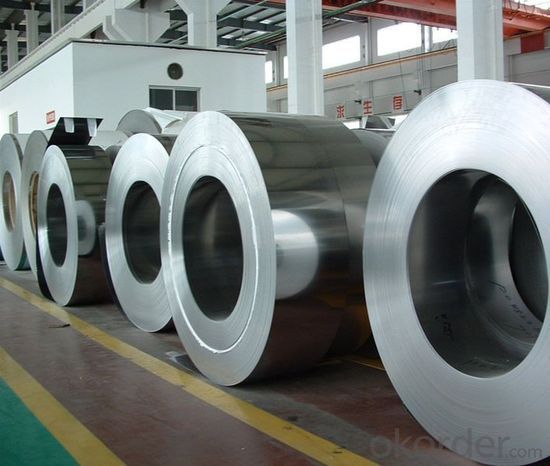
- Q: What is the thermal expansion coefficient of stainless steel strips?
- The thermal expansion coefficient of stainless steel strips can vary depending on the specific grade used. Compared to other materials, stainless steel generally has a low coefficient of thermal expansion. This coefficient measures the extent of expansion or contraction a material undergoes with temperature changes. Typically, stainless steel exhibits a thermal expansion coefficient ranging from approximately 10 to 17 µm/m°C (micrometers per meter per degree Celsius). This implies that with each degree Celsius rise in temperature, a stainless steel strip will lengthen by around 10 to 17 micrometers per meter. It is worth noting that the exact coefficient of thermal expansion may differ based on the specific alloy composition and heat treatment applied to the stainless steel. Therefore, it is advisable to refer to the manufacturer's specifications or carry out specific testing to ascertain the precise thermal expansion coefficient of a particular stainless steel strip.
- Q: Can 111 stainless steel strips be bent or formed without cracking?
- Yes, 111 stainless steel strips can be bent or formed without cracking, as stainless steel is known for its excellent formability and ductility. However, the specific bending or forming process, as well as the thickness and condition of the stainless steel strips, should be taken into consideration to ensure successful results.
- Q: What are the different types of surface defects in stainless steel strips?
- There are different types of surface defects that can occur in stainless steel strips, which can have an effect on their overall quality, appearance, and performance. Some commonly encountered surface defects in stainless steel strips are as follows: 1. Scratches: These are visible lines or grooves that can be seen on the surface of the strip. They can occur during the manufacturing process, handling, or transportation. Scratches can vary in depth and severity, and if they are deeper, they can potentially impact the corrosion resistance of the stainless steel. 2. Pits: Pitting refers to the formation of small cavities or depressions in localized areas of the strip's surface. Pits can be caused by different factors, such as exposure to corrosive environments, improper cleaning, or manufacturing defects. The presence of pits can compromise the integrity of the stainless steel and make it more susceptible to corrosion. 3. Stains: Stainless steel strips can develop stains or discoloration due to exposure to chemicals, heat, or improper cleaning methods. Stains can range from slight discoloration to more severe, deep stains that are difficult to remove. These defects can affect the appearance of the stainless steel and may also indicate a compromised protective oxide layer. 4. Roll marks: Roll marks are impressions or ridges that appear on the surface of the stainless steel strip during the rolling process. These marks can appear as lines or patterns and are usually caused by uneven pressure or improper alignment of the rolling equipment. Roll marks can impact the aesthetics of the stainless steel and may also affect its mechanical properties. 5. Weld defects: Stainless steel strips that are produced through welding processes can exhibit various types of weld defects, such as weld spatter, incomplete fusion, or excessive penetration. These defects can weaken the joint and reduce the overall strength and corrosion resistance of the stainless steel strip. 6. Surface contaminants: Surface defects in the form of contaminants, such as dirt, oil, grease, or foreign particles, can be present on stainless steel strips. These contaminants can be introduced during manufacturing, handling, or storage, and can have a negative impact on the performance and appearance of the stainless steel. It is important to note that the severity and impact of these surface defects can vary depending on the intended application of the stainless steel strip. Manufacturers implement various quality control measures to minimize these defects and ensure that the stainless steel strips meet the required standards.
- Q: What is the difference between austenitic and martensitic stainless steel strips?
- Austenitic stainless steel strips have a face-centered cubic crystal structure, which provides high corrosion resistance, excellent formability, and good weldability. On the other hand, martensitic stainless steel strips have a body-centered cubic crystal structure, making them harder and more brittle than austenitic steel. Martensitic steel is known for its high strength and hardness, but it sacrifices some of the corrosion resistance and formability found in austenitic steel.
- Q: What are the different types of finishes available for stainless steel strips?
- There are several types of finishes available for stainless steel strips, including brushed, mirror, satin, and patterned finishes. Each type of finish offers a different aesthetic appeal and can be chosen based on the desired look and functionality of the stainless steel.
- Q: What are the factors affecting the fatigue strength of 111 stainless steel strips?
- The factors affecting the fatigue strength of 111 stainless steel strips include the material composition, surface condition, manufacturing process, temperature, loading conditions, and the presence of any defects or discontinuities.
- Q: What kind of plastic surface friction and wear in stainless steel belt is relatively small?
- No solid modification of pure plastic on the surface of stainless steel wear is relatively small, such as polyethylene, PTFE and so on.
- Q: Are stainless steel strips suitable for decorative etching?
- Yes, stainless steel strips are suitable for decorative etching. Stainless steel is a versatile material that can be etched and engraved with intricate designs and patterns. It has a smooth and polished surface which makes it ideal for creating detailed and visually appealing decorative etchings. Additionally, stainless steel is highly durable and resistant to corrosion, ensuring that the etched designs will remain intact for a long time. This makes stainless steel strips a popular choice for various decorative applications such as signage, jewelry, art pieces, and architectural elements.
- Q: How does the price of stainless steel strips compare to other materials?
- The cost of stainless steel strips can fluctuate based on the particular grade and size of the strip, as well as the current state of the market. However, in general, stainless steel strips are typically pricier compared to alternative materials. This is primarily due to the higher expenses associated with production and the distinctive characteristics of stainless steel. Stainless steel is renowned for its exceptional resistance to corrosion, durability, and strength. It is also highly tolerant to heat and physical damage, making it suitable for a wide array of applications in various industries. These superior qualities contribute to the elevated price of stainless steel strips in comparison to other materials. On the other hand, materials such as carbon steel or aluminum are generally more economical. Carbon steel strips are extensively utilized due to their lower production costs and satisfactory strength properties. Aluminum strips, conversely, are lightweight and possess good corrosion resistance, but they are less robust and durable than stainless steel. When contemplating the price of stainless steel strips, it is crucial to assess the specific requirements of the intended use. Although stainless steel may necessitate a higher upfront investment, its long-term advantages, such as an extended lifespan and decreased maintenance costs, can make it a more cost-effective choice in many instances. Ultimately, numerous factors, including market demand, raw material availability, and manufacturing processes, influence the price of stainless steel strips. It is advisable to consult with suppliers or industry experts to obtain accurate and up-to-date pricing information for stainless steel strips and compare it with other materials in order to make an informed decision.
- Q: Are stainless steel strips flexible?
- Yes, stainless steel strips can be flexible depending on their thickness and width. Thinner and narrower stainless steel strips tend to be more flexible, while thicker and wider ones may have limited flexibility.
Send your message to us
Stainless Steel Coil 201 Hot Rolled Narrow Coil J4
- Loading Port:
- Lianyungang
- Payment Terms:
- TT OR LC
- Min Order Qty:
- 500 m.t.
- Supply Capability:
- 8000 m.t./month
OKorder Service Pledge
OKorder Financial Service
Similar products
Hot products
Hot Searches
Related keywords
